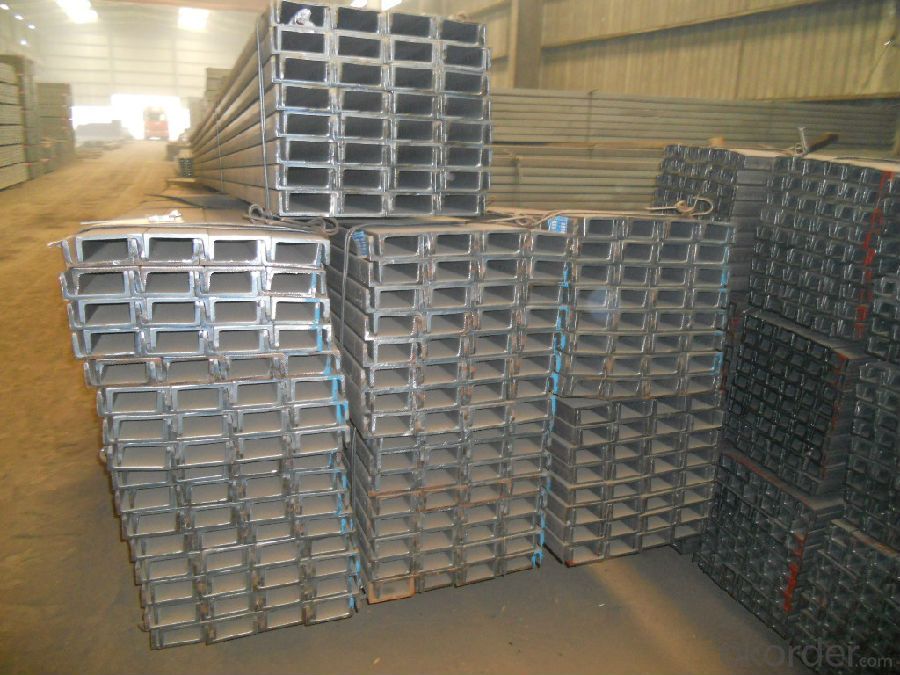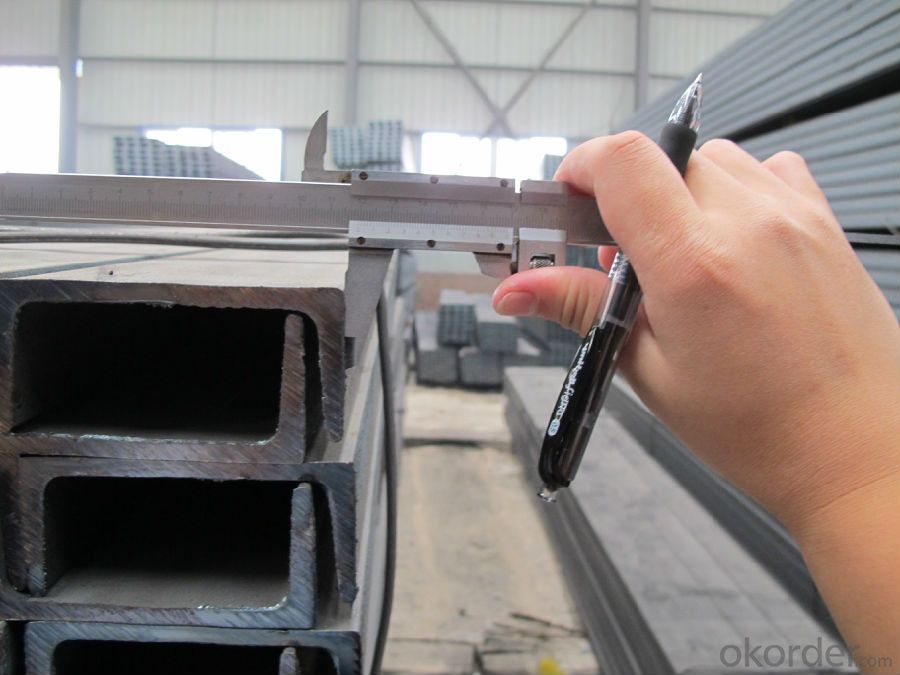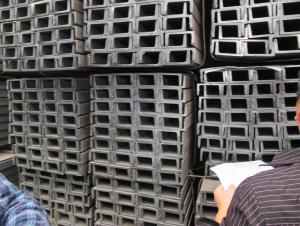Hot Rolled JIS Standard Channel with Many SIzes
- Loading Port:
- China Main Port
- Payment Terms:
- TT or LC
- Min Order Qty:
- -
- Supply Capability:
- -
OKorder Service Pledge
OKorder Financial Service
You Might Also Like
Product Description:
OKorder is offering STEEL CHANNEL at great prices with worldwide shipping. Our supplier is a world-class manufacturer of steel, with our products utilized the world over. OKorder annually supplies products to European, North American and Asian markets. We provide quotations within 24 hours of receiving an inquiry and guarantee competitive prices.
Product Applications:
1.The JIS channel can be devided into two kinds, namely common channel steel and light channel steel. The sizes of hot rolled common channel steel range from 5# to 40#. Meanwhile, the channel steel can be divided into cold forming sectional equal channel steel, cold forming sectional unequal channel steel, cold forming inner edge channel steel and outer edge channel steel.
2.The JIS channel is usually used for arch-itechtural structure, and they could be welded in order to support or hang a vari-ety of facilities. They are also usually used in combination with I beam. The channel steel with sizes under 14# is usually applied to construction engineering, as purline, while the channel steel with sizes above 16# is more likely to be used in building vehicle chassis structure and mechanical structure. Furthermore, the channel steel in sizes above 30# are target at building bridge structure, as tension bar.
3.In a word, the channel steel must possess perfect welding property, riveting property and mechanical property and so on.
Product Advantages:
OKorder's STEEL CHANNELare durable, strong, and resist corrosion.
Main Product Features:
· Premium quality
· Prompt delivery & seaworthy packing (30 days after receiving deposit)
· Corrosion resistance
· Can be recycled and reused
· Mill test certification
· Professional Service
· Competitive pricing
Product Specifications:
Minimum Order Quantity: 25 Tons Unit: m.t. Loading Port: Xingang Port
Supply Ability: 1000 Tons Per Day Payment Terms: TT or L/C
Product Description:
Specifications of Steel U Channel:
Standard Applied: GB Standard, EN Standard(UPN), JIS Standard
Sizes: 50mm to 300mm
Material Grade: Q235B, Q345B, S235JR, SS400, ASTM A36
Production Flow of JIS Channel:
1.The steel billet shall be heated in the high temperature furnace.
2. The heated steel billet shall be rolled five to nine times with the aim of shaping the general figure of steel u channel.
3. The rolled steel channel should be put onto the cooling bed to make the temperature low.
4. The JIS Channel should be straighted on the straightener.
5. The straighted steel u channel will be cut into meters by saw, as per customer's requirements.
6. At the last part of production, the channel steel must be tested in order to confirm that the finished products are completely free from crack, pore, slag, scab or fold on the surface.
Package & Delivery: Steel U Channel
The steel u channel will be packed in bundle with steel wire at each end of every bundle and color marking in order to help the customer to recognize his goods more easily at sight.
And steel u channel could be loaded into 20ft or 40ft container, or by bulk cargo. If the weight of each bundle reaches less than 3.5 mt, the loading by break bulk cargo should be choosed. When the weight of each bundle reaches less than 3mt, the loading by container should be choosed.
As for the transportaion from mill to loading port, the truck will be usually used. And the maximum quantity for each truck is 40mt.
All in all, we could do in accordance with customer's request
JIS CHANNEL | Standard h | Sectional b | Dimension s | t | Mass: Kg/m |
| (mm) | (mm) | (mm) | (mm) |
|
50x25 | 50 | 25 | 3.0 | 6.00 | 2.37 |
75X40 | 75 | 40 | 3.8 | 7.00 | 5.30 |
75X40 | 75 | 40 | 4.0 | 7.00 | 5.60 |
75X40 | 75 | 40 | 4.5 | 7.00 | 5.85 |
75X40 | 75 | 40 | 5.0 | 7.00 | 6.92 |
|
|
|
|
|
|
100X50 | 100 | 50 | 3.8 | 6.00 | 7.30 |
100X50 | 100 | 50 | 4.2 | 6.00 | 8.03 |
100X50 | 100 | 50 | 4.5 | 7.50 | 8.97 |
100X50 | 100 | 50 | 5.0 | 7.50 | 9.36 |
|
|
|
|
|
|
125X65 | 125 | 65 | 5.2 | 6.80 | 11.66 |
125X65 | 125 | 65 | 5.3 | 6.80 | 12.17 |
125X65 | 125 | 65 | 5.5 | 8.00 | 12.91 |
125X65 | 125 | 65 | 6.0 | 8.00 | 13.40 |
|
|
|
|
|
|
150x75 | 150 | 75 | 5.5 | 7.30 | 14.66 |
150x75 | 150 | 75 | 5.7 | 10.00 | 16.71 |
150x75 | 150 | 75 | 6.0 | 10.00 | 17.90 |
150x75 | 150 | 75 | 6.5 | 10.00 | 18.60 |
150x75 | 150 | 75 | 6.5 | 10.00 | 24.00 |
|
|
|
|
|
|
200X80 | 200 | 80 | 7.5 | 11.00 | 24.60 |
Images:


- Q:What are the common quality control measures for steel channels?
- Some common quality control measures for steel channels include visual inspections to check for surface defects, dimensional measurements to ensure proper size and shape, hardness testing to assess the strength of the material, and chemical analysis to verify the composition of the steel. Additionally, destructive and non-destructive testing methods such as ultrasonic testing and magnetic particle inspection may be used to detect internal flaws or defects.
- Q:Channel steel is a strip of steel with a cross section.
- The box is denoted by 12# (H) * leg width (b) * waist thickness (d), such as 120*53*5, which means that the waist height is 120 mm, the width of the leg is 53 mm, and the channel is 5 mm thick, or called channel steel. The same height of the channel, if there are several different leg width and waist thickness, also need to add a, B, C on the right side of the model to distinguish, such as 25a#, 25b#, 25c# and so on
- Q:Where can I find the tensile strength of channel steel?
- Tensile strength and yield strength are independent of size and size, but only material.Sigma S shall be the yield strength and the ultimate tensile strength shall be sigma BThe yield strength of Q215 material is 215MPa, and tensile strength is about 335-410MPaThe yield strength of Q235 material is 235MPa, and tensile strength is about 375-460MPa
- Q:Can steel channels be used in sports facility construction?
- Yes, steel channels can be used in sports facility construction. They are commonly used to provide support and structural integrity to various components of the facility, such as bleachers, scoreboards, and equipment racks. Steel channels offer strength, durability, and versatility, making them suitable for withstanding the demands of a sports facility environment.
- Q:What are the different methods for reinforcing steel channels against bending?
- There are several methods for reinforcing steel channels against bending. Some common methods include adding additional steel plates or angles to increase the strength and rigidity of the channel, using stiffeners or braces to provide additional support, and increasing the thickness of the channel itself. Another method is to use composite materials, such as carbon fiber sheets, to enhance the bending resistance of the steel channel. The choice of method depends on the specific requirements and constraints of the application.
- Q:What are the different types of connections used for steel channels in bridges?
- Steel channels in bridges can be joined using various types of connections, each with its own benefits and considerations. Some commonly used connection types are as follows: 1. Welded connections: Welding is widely employed to connect steel channels in bridges. This method involves heating the materials until they melt and then fusing them together. Welded connections are renowned for their strength and durability. However, skilled labor and proper quality control are necessary to ensure the integrity of the welds. 2. Bolted connections: Bolted connections entail using bolts and nuts to fasten steel channels. This type of connection offers flexibility as it allows for disassembly and reassembly if required. It is also relatively easier to install and inspect compared to welded connections. Nevertheless, periodic maintenance may be needed to ensure the bolts remain tight. 3. Riveted connections: In older bridge constructions, rivets were commonly used. This method involves inserting a rivet into a pre-drilled hole and deforming it to secure the steel channels. Riveted connections provide good shear resistance, but they are less frequently used today due to the labor-intensive installation process and difficulties in inspection and maintenance. 4. High-strength bolted connections: High-strength bolts, which possess greater tensile strength than regular bolts, are commonly employed in modern bridge constructions. These connections offer high resistance to shear and tension forces. Specialized tools and careful installation are required to achieve the desired strength. 5. Moment connections: Moment connections are designed to transfer bending moments between steel channels in bridges. They are typically used in situations where the bridge is subjected to significant lateral forces, such as in earthquake-prone areas. Moment connections are usually welded and necessitate meticulous design and analysis to ensure their performance under different loading conditions. It is important to consider various factors, including bridge design, anticipated loads, construction techniques, and maintenance requirements when selecting connection types. Engineers and designers take these factors into account to determine the most suitable connections that will provide the necessary strength, durability, and safety for steel channels in bridges.
- Q:What are the factors to consider when determining the appropriate length of a steel channel?
- When it comes to determining the ideal length for a steel channel, there are several factors that must be taken into consideration. These factors encompass the purpose of the channel, the structural requirements, and the limitations imposed by manufacturing and transportation processes. To begin with, the intended use of the steel channel plays a pivotal role in determining its length. The purpose for which the channel will be employed, whether it be to support beams, frame structures, or act as a conduit, will dictate the appropriate length. It is imperative to thoroughly assess the specific requirements of the project and ensure that the chosen length of the channel aligns with the overall design plan. Additionally, the structural requirements of the application must be accounted for. Elements such as load-bearing capacity, deflection limits, and the necessity for additional support or reinforcement can influence the suitable length of the steel channel. Engineering calculations and structural analysis should be carried out to ascertain the necessary dimensions and ensure that the channel is capable of withstanding the anticipated forces and stresses. Furthermore, it is important to consider the limitations imposed by manufacturing and transportation processes. Steel channels are typically produced in standard lengths, so it is crucial to select a length that minimizes material waste and cost. The logistics of transportation, such as the size of the delivery vehicle or the availability of suitable transportation methods, may also impact the maximum length that can be feasibly used for a project. Other factors that should be taken into account include the installation process, fabrication requirements, and any potential future modifications. It is vital to evaluate these aspects in order to ensure that the chosen length of the steel channel is practical, cost-effective, and aligned with the overall objectives of the project. In conclusion, determining the appropriate length of a steel channel necessitates considering the intended use, structural requirements, manufacturing and transportation limitations, installation process, fabrication requirements, and potential future modifications. By carefully assessing these factors, one can select a length that fulfills the needs of the project while guaranteeing structural integrity and efficiency.
- Q:How are steel channels installed on-site?
- Steel channels are typically installed on-site by first preparing the foundation or support structure. The channels are then positioned and aligned according to the design specifications. They are secured in place using welding, bolting, or concrete embedding methods. The installation process may also involve leveling, aligning, and ensuring proper connections with other structural elements.
- Q:Are steel channels suitable for agricultural buildings?
- Yes, steel channels are suitable for agricultural buildings. They are strong and durable, making them ideal for supporting the structure and withstanding the harsh conditions often found in agricultural settings. Additionally, steel channels can be easily customized and fabricated to meet specific design requirements, making them versatile for various applications within agricultural buildings.
- Q:How do steel channels perform under live loads?
- Steel channels, commonly used in construction projects, are known for their durability and reliability. They excel in supporting heavy loads and distributing them evenly along their length, making them suitable for applications with live loads, like people or equipment. The design of steel channels efficiently resists bending and buckling, ensuring the integrity and stability of the structure. Their shape and cross-section provide a high moment of inertia, contributing to their superior load-carrying capacity. This means they can withstand larger live loads without excessive deflection or deformation. In addition, steel channels offer a high strength-to-weight ratio, making them ideal for structures that require significant load-bearing capacity while minimizing weight. This advantage is particularly valuable in applications like bridges or overhead cranes, where the weight of the structure needs to be minimized. Furthermore, steel channels are highly resistant to fatigue, allowing them to endure repeated loading and unloading without significant loss in performance. This characteristic makes them well-suited for applications involving dynamic loads, such as moving vehicles or heavy machinery. To summarize, steel channels perform exceptionally well under live loads. They support heavy loads, distribute them evenly, resist bending and buckling, and withstand repeated loading. These qualities make steel channels a reliable and efficient choice for various construction projects that require superior load-bearing capacity and structural stability.
1. Manufacturer Overview |
|
|---|---|
| Location | |
| Year Established | |
| Annual Output Value | |
| Main Markets | |
| Company Certifications | |
2. Manufacturer Certificates |
|
|---|---|
| a) Certification Name | |
| Range | |
| Reference | |
| Validity Period | |
3. Manufacturer Capability |
|
|---|---|
| a)Trade Capacity | |
| Nearest Port | |
| Export Percentage | |
| No.of Employees in Trade Department | |
| Language Spoken: | |
| b)Factory Information | |
| Factory Size: | |
| No. of Production Lines | |
| Contract Manufacturing | |
| Product Price Range | |
Send your message to us
Hot Rolled JIS Standard Channel with Many SIzes
- Loading Port:
- China Main Port
- Payment Terms:
- TT or LC
- Min Order Qty:
- -
- Supply Capability:
- -
OKorder Service Pledge
OKorder Financial Service
Similar products
New products
Hot products
Hot Searches
Related keywords






























